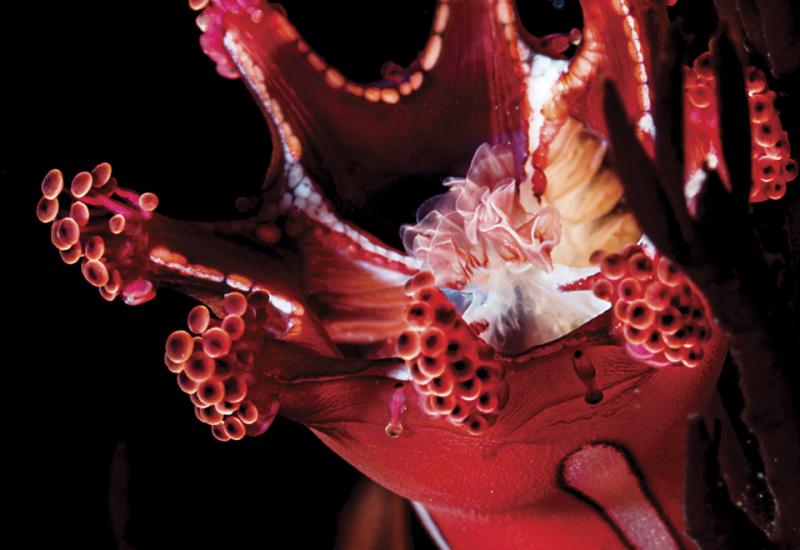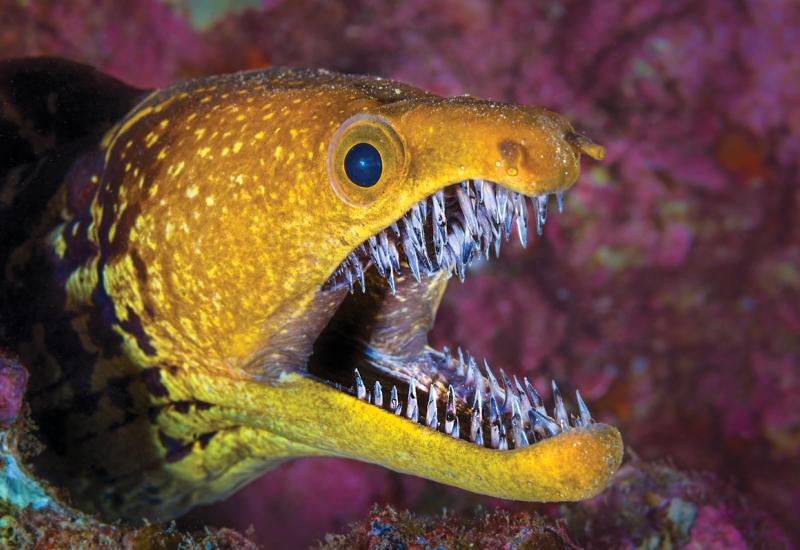Critter Hunt: Lisa's Mantis Shrimp
The first animal my night beam strikes is a large mantis shrimp with its head extending from a burrow. Even though I’ve seen dozens of these monsters before, the sight of one always makes me stop in my tracks.
I inch forward until we’re eye to eye. And oh, what eyes they are — oversized, bilobed, bifocal and mounted on stalks like periscopes. Some claim the mantis eye is the most sophisticated on the planet. But the claws folded back against the body of this Lisa’s mantis are what catch my attention. We’re in Bali, and big, hole-dwelling Lisa’s mantis shrimps — also known as spearing mantis — can reach a foot in length and uses its claws like street thugs wielding switchblades. In just a few milliseconds, Lisa’s mantis shrimp can impale their prey, and they have been known to injure divers. I’m keeping a safe distance from this one when a blunt-headed white shrimp crawls out of the burrow. The 1-inch shrimp clambers across the mantis’ claws and antennae before disappearing back into the burrow. Delighted, I take a picture.
A few weeks later, I email the image to a shrimp specialist in the Netherlands, who says he’s been aware of the species since its photo first appeared in a German crustacean guide in the 1990s. He speculates that it is a scientifically undescribed snapping shrimp in the genus Athanas.
When you consider that a diver will have to challenge the mantis’ claws in order to capture a specimen (scientists usually need two specimens in order to ensure a species is distinct from similar species), it’s easy to understand why the shrimp will probably remain scientifically undocumented for some time to come.
The first animal my night beam strikes is a large mantis shrimp with its head extending from a burrow. Even though I’ve seen dozens of these monsters before, the sight of one always makes me stop in my tracks.
I inch forward until we’re eye to eye. And oh, what eyes they are — oversized, bilobed, bifocal and mounted on stalks like periscopes. Some claim the mantis eye is the most sophisticated on the planet. But the claws folded back against the body of this Lisa’s mantis are what catch my attention. We’re in Bali, and big, hole-dwelling Lisa’s mantis shrimps — also known as spearing mantis — can reach a foot in length and uses its claws like street thugs wielding switchblades. In just a few milliseconds, Lisa’s mantis shrimp can impale their prey, and they have been known to injure divers. I’m keeping a safe distance from this one when a blunt-headed white shrimp crawls out of the burrow. The 1-inch shrimp clambers across the mantis’ claws and antennae before disappearing back into the burrow. Delighted, I take a picture.
A few weeks later, I email the image to a shrimp specialist in the Netherlands, who says he’s been aware of the species since its photo first appeared in a German crustacean guide in the 1990s. He speculates that it is a scientifically undescribed snapping shrimp in the genus Athanas.
When you consider that a diver will have to challenge the mantis’ claws in order to capture a specimen (scientists usually need two specimens in order to ensure a species is distinct from similar species), it’s easy to understand why the shrimp will probably remain scientifically undocumented for some time to come.










